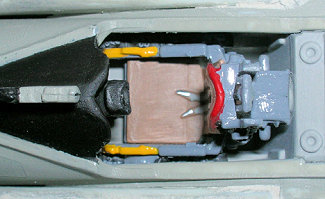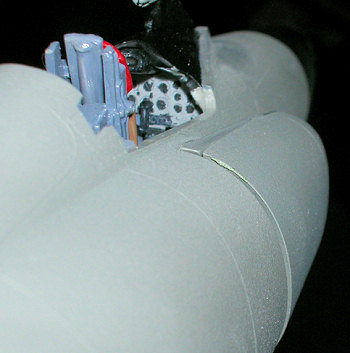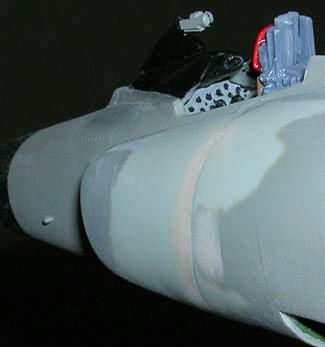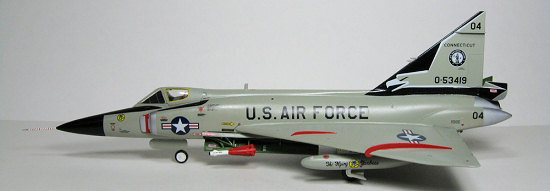
Revell 1/48 F-102A Delta Dagger
| KIT #: | 04856 |
| PRICE: | $25.00 from a local shop |
| DECALS: | Two options |
| REVIEWER: | Jared McIver |
| NOTES: |

| HISTORY |
The F-102A Delta Dagger,
known affectionately as “The Deuce”, is a jet that has many distinctions. Among
them is the first delta wing equipped fighter, the first supersonic all-weather
interceptor and interestingly enough the first fighter designed without an
integrated gun. The idea behind The Deuce’s job description was not much more
than to intercept threatening long range bombers and equalize them using guided
AIM-4 missiles or unguided FFAR rockets, depending on the onboard configuration
and  proximity to the target.
proximity to the target.
While regarded as more of an interim solution for the Air Force’s interceptor needs in preparation for its directly related and vastly improved F-106 successor, the 102 maintained quite a presence with the ADC as evidenced by its use in 32 squadrons at one point. As 1970 approached, all F-102’s were transferred to Air National Guard units until final service retirement in 1976. It was at that juncture that many were converted for target drone use for the ever developing guided missile programs. An interesting fact regarding the F-102 was that unlike the more able bodied F-106, it actually saw combat in Vietnam as, surprisingly enough, a ground support craft that used its infrared Falcons and unguided rockets for ground attack!
Though the Deuce is upstaged in almost every category by the visually similar F-106, it still holds a special place in USAF aviation history and in the hearts of Century Series lovers the world over.
| THE KIT |
 This kit has most assuredly
seen its fair share of re-box efforts via Revell and Monogram. This particular
offering is from Revell Germany, is rated as a level “4” kit and has 103 parts.
These are presented within 5 sprues molded in light gray with raised details and
the proverbial separately bagged clear tree containing both fore and aft
portions of the canopy. The clear parts were relatively transparent and free of
mars. The majority of the colored parts suffered from a little flash here and
there and only a few detected sink marks were present throughout.
This kit has most assuredly
seen its fair share of re-box efforts via Revell and Monogram. This particular
offering is from Revell Germany, is rated as a level “4” kit and has 103 parts.
These are presented within 5 sprues molded in light gray with raised details and
the proverbial separately bagged clear tree containing both fore and aft
portions of the canopy. The clear parts were relatively transparent and free of
mars. The majority of the colored parts suffered from a little flash here and
there and only a few detected sink marks were present throughout.
Options include a support crew with ladder, a pilot, open/closed weapons bay, open/ closed gear, open/closed brakes, drop tanks and markings for two planes: 56-1264 out of the 525th FIS, Bitburg AFB 1960 and 55-3419 out of the 118th FIS, Connecticut ANG 1968, aka “The Flying Yankees”. I hear a lot of talk about many box stock decal sheets being useless but these seemed to work very well for me with no apparent problems, especially with some Microset application.
| CONSTRUCTION |
Keep in mind this is the
first kit I’ve built since I was maybe 11 years old, some 17 years ago. I had
very little clue about how to do things correctly, err, to reproduce a realistic
jet via model kit until I encountered Modeling Madness. It was a short time
after that when I decided to start this build. At any rate, assembly was pretty
straightforward. The cockpit has moderate detail that can be brought out with
some careful picking and dry-brushing, however, typical of many jets within the
era the ejection seat is  highlighted
greatly and most all else is hidden, especially with a closed canopy, so I
decided to do minimal work on much except the seat. Said seat has ample detail
that can be painted to present what seems to be quite an attractive TALCO seat,
complete with belts and buckles.
highlighted
greatly and most all else is hidden, especially with a closed canopy, so I
decided to do minimal work on much except the seat. Said seat has ample detail
that can be painted to present what seems to be quite an attractive TALCO seat,
complete with belts and buckles.
During fuselage and wing
assembly there was much work that had to be done with all seams- the top and
bottom of the engine, both ventral and dorsal fuselage unions, the seams for the
wing “sandwich”, those within the stabilizer (gaping!) and the wing roots. I
used mostly Squadron white putty for a majority of the situations and finished
the wing root work with a smooth application of CA (of the thick persuasion).
The raised detail on this jet was easily erased even with careful protective
masking during sanding, and while I decided to scribe some of them back to give
the effect of a presence, the reality is on the real thing the panel lines and
such details are practically invisible, especially on a new example. There were
som e sink marks on the
opposite side of the wing wheel well moldings that needed some attention as well
as the stabilizer, but nothing major. After working on some of the smaller
sub-assemblies, it came time to do the intake cowls and this portion of
construction posed some problems. The intake pieces were bowed versus the side
of the fuselage and could not be manipulated to fit without becoming too tall
for their spots. The solution was to affix them as straight as possible, knock
the edges down that bowed out on the sides of the jet, and use putty in gradual
applications with sanding to make a smooth transition. I then finished with some
CA along the top and bottom seams, and applied more CA to the side putty work
with further fine sanding to give it some strength as this particular area
becomes a well-used grabbing place during construction and detailing. I attached
the radome and filled the seam so it was undetectable.
e sink marks on the
opposite side of the wing wheel well moldings that needed some attention as well
as the stabilizer, but nothing major. After working on some of the smaller
sub-assemblies, it came time to do the intake cowls and this portion of
construction posed some problems. The intake pieces were bowed versus the side
of the fuselage and could not be manipulated to fit without becoming too tall
for their spots. The solution was to affix them as straight as possible, knock
the edges down that bowed out on the sides of the jet, and use putty in gradual
applications with sanding to make a smooth transition. I then finished with some
CA along the top and bottom seams, and applied more CA to the side putty work
with further fine sanding to give it some strength as this particular area
becomes a well-used grabbing place during construction and detailing. I attached
the radome and filled the seam so it was undetectable.
I assembled the landing gear
pieces and various doors with their associated little tiny bits. I used CA for
this for obvious reasons, but the front strut in particular has a very vague
connection to the wheel well and seemingly relies solely on CA for integrity. A
fair amount of time was taken to assemble the open bay contents, such as the
missile rails and their AIM-4’s, doors, sills, rocket pods, etc. I spent quite a
handful of concentration and creativity affixing the side sills to the open bay-
they are not given the appropriate size attachment “nubs” and require some
careful light bending and CA hold coaxing to conform to the sides of the bays. I
had to fashion a VERY small shim out of junk sprue for one of the slat feet for
it to even reach the edge of the open bay. Speaking of using left over styrene,
there is a little piece atop the fuselage in line with the fo re
portion of the wing root that evidently is some part of the jet’s communication
equipment. This piece is molded with an extremely thin base connection to the
aircraft, about 75% thinner than the piece itself. I knocked this piece off
incessantly, and finally ended up losing it for a long enough time to decide to
fashion my own. I attached the custom unit with CA. I ended up eventually
finding the original one and kept it to put under my pillow for the tiny piece
fairy who obviously was trying the entire build time to steal it.
re
portion of the wing root that evidently is some part of the jet’s communication
equipment. This piece is molded with an extremely thin base connection to the
aircraft, about 75% thinner than the piece itself. I knocked this piece off
incessantly, and finally ended up losing it for a long enough time to decide to
fashion my own. I attached the custom unit with CA. I ended up eventually
finding the original one and kept it to put under my pillow for the tiny piece
fairy who obviously was trying the entire build time to steal it.
The canopy was a project in itself. I had to blend the rear clear portion to the canopy cradle/frame to make it look uniform. I did this with CA and sanding. I noticed that if positioned in a closed mode, the back of said frame protruded up past the top of the jet’s spine and had a somewhat loose fit (in terms of seams) with the cockpit. Some minor yet careful filing corrected this. I also had to sand/file the cockpit ledges to more accurately match the frame dimensions. The front portion had its own problems. When positioned with the rear canopy portion in place on the cockpit, the point of the front reached out past the provision at the base of the cockpit (sorta near where your typical infrared sensor would reside). I had to build this up with CA, shape, build up, shape until it fell in line with the nose ridge of the forward canopy. I also helped the cause a bit by shaving the edge of this canopy portion ever so slightly, to effectively alter the slope and coax it to meet the base tip I fashioned. After all of this fit reasonably well in a dry state, I used extremely tiny spots of CA to affix the edges of the frames to the jet, and filled the remaining seams with white glue until smooth. This helped the appearance of the seams quite a bit.
| COLORS & MARKINGS |
Let me preface this by
mentioning that I was unsure of how good this model would turn out when I bought
it as it was indeed my first, so I decided from the start to use colors that
were “close enough” and gave the strong impression of a Deuce. I do not own an
airbrush (yet), and had to rely on shelved bottled Testors enamel for brushwork
and their spray brethren for large span work. I used Testors Dark Aircraft Gray
spray for the skin, the radome was masked with Tamiya tape and hit with Testors
Flat Black. I used Parafilm (AMAZING STUFF!) for masking the cockpit pieces and
intake designs, the latter of which was sprayed with Testors
 Silver along with
the Tamiya masked tail engine area. I used a custom enamel color mix for the
burner can itself and the inner nacelle sections back there, and used Dark Gray
enamel for the inside of the engine. The wells, inner portions of doors, missile
rails, inside of brakes and the like were brushed at appropriate stages of
construction with Testors Flat Green. The inside of the cockpit also was brush
painted with visually accurate Testors enamels. All of the bare metal pieces,
wheels and various doo-dads were painted according to the instructed recommended
colors. I decided to paint the wing fences and missile rears with Testors Red
enamel and the missile fronts were painted with Gloss white, which was silly
considering my later work with various top coats. Regarding top coating, I
prepared the model after the base colors were done with Model Master Clear
Lacquer. I applied the decals using Microset and as previously mentioned had
very little issue with this process. I topped off the decaled jet with Testors
Clear Lacquer (which I assume is the same as the Model Master version) and brush
painted Testors Dull Cote within the wheel wells, on the tires, atop the
anti-glare panels and also over the radome. I used Testors bottled Flat White
and Flat Red for the spiral work on the nose pitot and tail hook.
Silver along with
the Tamiya masked tail engine area. I used a custom enamel color mix for the
burner can itself and the inner nacelle sections back there, and used Dark Gray
enamel for the inside of the engine. The wells, inner portions of doors, missile
rails, inside of brakes and the like were brushed at appropriate stages of
construction with Testors Flat Green. The inside of the cockpit also was brush
painted with visually accurate Testors enamels. All of the bare metal pieces,
wheels and various doo-dads were painted according to the instructed recommended
colors. I decided to paint the wing fences and missile rears with Testors Red
enamel and the missile fronts were painted with Gloss white, which was silly
considering my later work with various top coats. Regarding top coating, I
prepared the model after the base colors were done with Model Master Clear
Lacquer. I applied the decals using Microset and as previously mentioned had
very little issue with this process. I topped off the decaled jet with Testors
Clear Lacquer (which I assume is the same as the Model Master version) and brush
painted Testors Dull Cote within the wheel wells, on the tires, atop the
anti-glare panels and also over the radome. I used Testors bottled Flat White
and Flat Red for the spiral work on the nose pitot and tail hook.
| CONCLUSIONS |
 It’s hard for me to gauge
where this kit ranks in the grand scheme of things as I’ve no experience with
any others, however, considering I’ve spent incredible amounts of time reading
the reviews contained with MM, I can assume this is your typical Monogram/Revell
kit that can be fashioned into a rather attractive representation with some
massaging. I spent about 2+ months on this because I had to learn on the job,
and am entirely too anal. I suspect my next model, a Delta Dart, will move along
quite a bit faster; however I still feel my modeling career will have many
episodes of self-scrutiny and incredibly ridiculous worry rooted in my fervor
for details. Hey, if it turns out looking like the jet it’s supposed to, then in
my opinion it’s all worth it!
It’s hard for me to gauge
where this kit ranks in the grand scheme of things as I’ve no experience with
any others, however, considering I’ve spent incredible amounts of time reading
the reviews contained with MM, I can assume this is your typical Monogram/Revell
kit that can be fashioned into a rather attractive representation with some
massaging. I spent about 2+ months on this because I had to learn on the job,
and am entirely too anal. I suspect my next model, a Delta Dart, will move along
quite a bit faster; however I still feel my modeling career will have many
episodes of self-scrutiny and incredibly ridiculous worry rooted in my fervor
for details. Hey, if it turns out looking like the jet it’s supposed to, then in
my opinion it’s all worth it!
| REFERENCES |
Airliners.net F-102 image collection
Nationalmuseum.af.mil cockpit image collection
November 2007
If you would like your product reviewed fairly and fairly quickly, please contact the editor or see other details in the Note to Contributors.